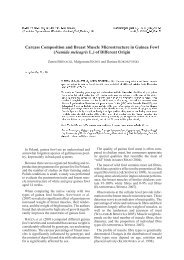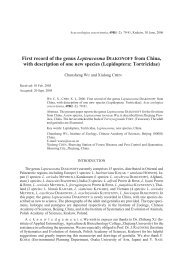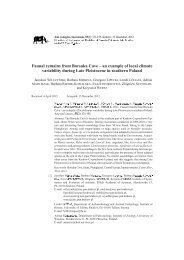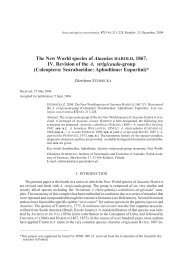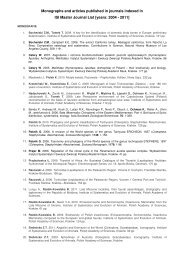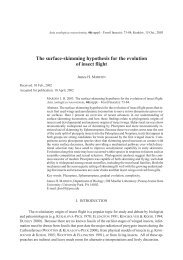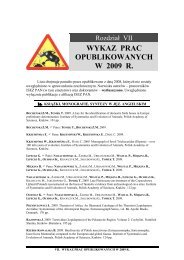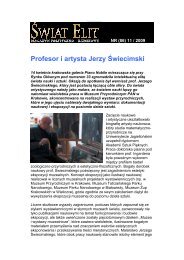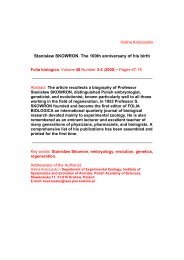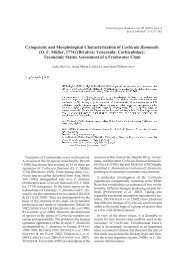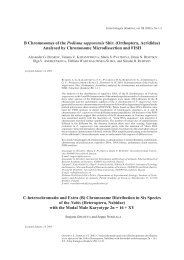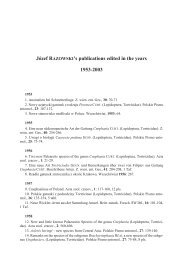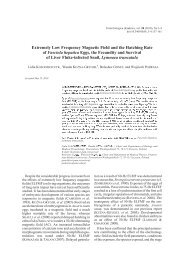Rafael Gioia MARTINS-NETO, Oscar Florencio GALLEGO
Rafael Gioia MARTINS-NETO, Oscar Florencio GALLEGO
Rafael Gioia MARTINS-NETO, Oscar Florencio GALLEGO
Create successful ePaper yourself
Turn your PDF publications into a flip-book with our unique Google optimized e-Paper software.
Triassic insect fauna from South America<br />
253<br />
restricted distribution in the Upper Triassic of Gondwana to the Lower Jurassic Inferior of Laurasia.<br />
Twenty three species are known for the Australian Upper Triassic: Chiliocycla scolopoides TIL-<br />
LYARD 1920; Mesoscytina australis TILLYARD 1920; Mesoscytina affinis TILLYARD 1920; Mesodiphthera<br />
subcostalis TILLYARD 1920; Mesodiphthera prosboloides TILLYARD 1922;<br />
Mesodiphthera dunstani TILLYARD 1922; Triassojassus proavitus TILLYARD 1920; Triassocarta<br />
subcostalis TILLYARD 1920; Mesocixius triassicus TILLYARD 1920; Mesocixiodes terminoneura<br />
TILLYARD 1920; Triassoscytina incompleta EVANS 1956; Triassoscytinopsis stenuata EVANS<br />
1956; Triassoscytinopsis aberrans EVANS 1956; Triassoscytinopsis paranotalis EVANS 1956;<br />
Mesothymbris perkinsi EVANS 1956; Mesothymbris woodwardi EVANS 1956; Mesonirvana<br />
abrupta EVANS 1956; Triassoscelis anomala EVANS 1956; Mesocicadella venosa EVANS 1956;<br />
Triassocotis australis EVANS 1956; Apheloscysta mesocampia TILLYARD 1922; Crosbella elongata<br />
EVANS 1956; and Crosbella alata EVANS 1956. The species Scytinoptera distorta RIEK 1976 is<br />
known from the South Africa Upper Triassic. From the Argentina Upper Triassic, eight species are<br />
known: Tipuloidea rhaetica WIELAND 1925; Argentinocicada magna <strong>MARTINS</strong>-<strong>NETO</strong> &GAL-<br />
LEGO, 1999; Argentinocicada minima <strong>MARTINS</strong>-<strong>NETO</strong> &<strong>GALLEGO</strong> 1999; Potrerillia nervosa MAR-<br />
TINS-<strong>NETO</strong> &<strong>GALLEGO</strong> 1999; Australocicada arcucciae <strong>MARTINS</strong>-<strong>NETO</strong> &<strong>GALLEGO</strong> 2001,<br />
Gualoscytina mayae <strong>MARTINS</strong>-<strong>NETO</strong> &<strong>GALLEGO</strong> n. sp., a possible new genus et species (Fig. 6 I),<br />
and Argentinopheloscyta forsterae <strong>MARTINS</strong>-<strong>NETO</strong> &<strong>GALLEGO</strong> n. sp. The only species known<br />
from the Upper Triassic of Germany is Saaloscytina perreticulata BRAUCKMANN &SCHLÜTER<br />
1993. The record of this group in the Lower Jurassic consists of seven species: Mesocixiella asiatica<br />
MARTYNOV 1937; Mesocixiella furcata MARTYNOV 1937; Mesocixiella extensa MARTYNOV 1937<br />
and Mesocixiella major MARTYNOV, 1937. All of these are from the Lower Jurassic of Russia. Finally,<br />
Archijassus vicinus HANDLIRSCH 1906; Liojassus affinis HANDLIRSCH 1906; and Mesojassus<br />
pachynavus HANDLIRSCH 1906, are known from the Lower Jurassic of Germany.<br />
As in the previously discussed group, the Scytinopteromorpha origin is clearly gondwanan, well<br />
represented in Argentina and Australia, index fossils for the Upper Triassic of Gondwana, and for<br />
the Lower Jurassic of Laurasia through Asia, reaching Germany, westward of which they are unknown<br />
on the continent. The paleogeography of Scytinopteromorpha is virtually identical of the<br />
previously discussed groups.<br />
Two important zones based on the insect taxa discussed above may be proposed:<br />
(a) the association zone Dysmorphoptila/Mesocixiella, marking the Lower Jurassic (Liassic) of<br />
Laurasia, correlating the deposits of central Asia and of Europe; and<br />
(b) association zone Polycitellidae/Dysmorphoptiloides, marking the upper part of the Middle Triassic<br />
to the beginning of the Upper Triassic in Gondwana, correlating the deposits of Argentina<br />
(Potrerillos and Los Rastros formations), of the south of Africa (Molteno Formation), of Antarctica<br />
(Graham Land Series), of Australia (Ipswich Series) and of the south of Asia.<br />
The Triassic of Gondwana has very representative insect fossils that allow, through their distribution,<br />
correlation to be established between several deposits. The Triassic insect assemblage of<br />
Argentina (Potrerillos and Los Rastros formations) is virtually identical with that of the Ipswich Series<br />
in Australia. The Ipswich Series in Australia is probably the region of origin for these insect<br />
groups.<br />
The dispersion routes for insects are very well defined from Australia through Antarctica to Argentina,<br />
and are not very different to the conchostracans migration routes proposed above. The faunas<br />
of the Triassic of South Africa and of South Brazil are not correlated to each other (in the case of<br />
Brazil, this is likely a result of few records reported), but correlation of the South Africa deposits<br />
with those of the Argentina + Australia Triassic is very low. On the other hand, Triassic conchostracan<br />
faunas from Argentina are correlated with those of Chile and Brazil, and these differ greatly<br />
with the faunas of South Africa and Australia.<br />
Different migration trackway of insects and conchostracans would be due to their distinct dispersion<br />
forms. Conchostracans migrate by wind transport, and insects mainly by powered flight.<br />
<strong>GALLEGO</strong> &MELCHOR (2000) mentioned that the presence of some conchostracan taxa in the



